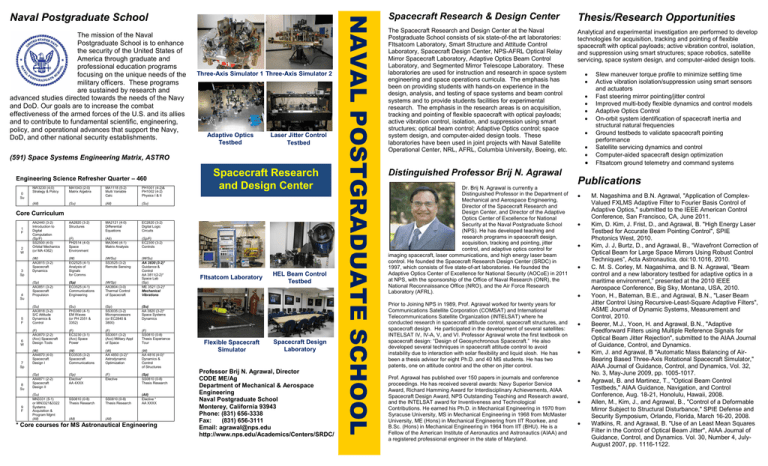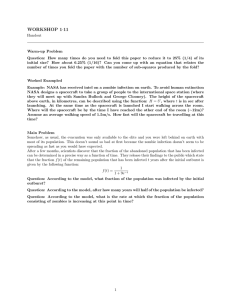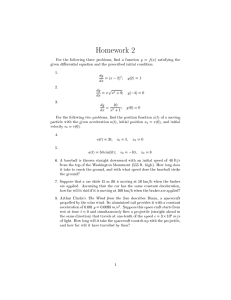N AV Naval Postgraduate School
advertisement

The mission of the Naval Postgraduate School is to enhance the security of the United States of America through graduate and professional education programs focusing on the unique needs of the military officers. These programs are sustained by research and advanced studies directed towards the needs of the Navy and DoD. Our goals are to increase the combat effectiveness of the armed forces of the U.S. and its allies and to contribute to fundamental scientific, engineering, policy, and operational advances that support the Navy, DoD, and other national security establishments. Three-Axis Simulator 1 Three-Axis Simulator 2 Adaptive Optics Testbed Laser Jitter Control Testbed (591) Space Systems Engineering Matrix, ASTRO Engineering Science Refresher Quarter – 460 0 Su NW3230 (4-0) Strategy & Policy MA1043 (2-0) Matrix Algebra MA1118 (5-2) Multi Variable Calc PH1001 (4-2)& PH1002 (4-2) Physics I & II (All) (Su) (All) (Su) AA2440 (3-2) Introduction to Digital Computation (Sp/F) SS2500 (4-0) Orbital Mechanics (or MA 4362) AA2820 (3-2) Structures MA2121 (4-0) Differential Equations EC2820 (3-2) Digital Logic Circuits (F) PH2514 (4-0) Space Environment (All) MA3046 (4-1) Matrix Analysis (Sp/F) EC2300 (3-2) Controls (W) AA3815 (3-2) Spacecraft Dynamics (W) EO2525 (4-1) Analysis of Signals for Comms (W/Su) SS3525 (3-2) Remote Sensing (Sp) EO3525 (4-1) Communications Engineering (W/Sp) AA3804 (3-0) Thermal Control of Spacecraft (W/Su) AA 3830 (3-2)* Guidance & Control AA 3811(2-2)* Space Lab (Sp) ME 3521 (3-2)* Mechanical Vibrations Spacecraft Research and Design Center Core Curriculum 1 F 2 W 3 Sp 4 Su 5 F 6 W 7 Sp 8 Su 9 F (Sp) AA3851 (3-2) Spacecraft Propulsion (Su) AA3818 (3-2) S/C Attitude Dynamics & Control (Su) PH3360 (4-1) EM Waves (or PH 2351 & 3352) (Sp) SS3035 (3-2) Microprocessors (or EC2840 & 3800) (Su) AA 3820 (3-2)* Space Systems Dynamics (F) AA3870 (2-2) (Acc) Spacecraft Design Tools (F) EC3230 (3-1) (Acc) Space Power (F) SS3001 (3-2) (Acc) Military Appl of Space (F) SS0810 (0-8) Thesis Experience Tour (W) AA4870 (4-0) Spacecraft Design I (W) EO3535 (3-2) Spacecraft Communications (W) AA 4850 (3-2)* Astrodynamic Optimization (W) AA 4816 (4-0)* Dynamics & Control of Structures (Sp) AA4871 (2-2) Spacecraft Design II (Sp) Elective* AA 4XXX (F) Elective (Sp) SS0810 (0-8) Thesis Research SS0810 (0-8) Thesis Research SS0810 (0-8) Thesis Research (All) (All) (Su) MN3331 (5-1) or MN3321&3322 Systems Acquisition & Program Mgmt (All) (All) Elective * AA XXXX * Core courses for MS Astronautical Engineering Fltsatcom Laboratory Flexible Spacecraft Simulator HEL Beam Control Testbed Spacecraft Design Laboratory Professor Brij N. Agrawal, Director CODE ME/Ag Department of Mechanical & Aerospace Engineering Naval Postgraduate School Monterey, California 93943 Phone: (831) 656-3338 Fax: (831) 656-3111 Email: agrawal@nps.edu http://www.nps.edu/Academics/Centers/SRDC/ NAVAL POSTGRADUATE SCHOOL Naval Postgraduate School Spacecraft Research & Design Center Thesis/Research Opportunities The Spacecraft Research and Design Center at the Naval Postgraduate School consists of six state-of-the art laboratories: Fltsatcom Laboratory, Smart Structure and Attitude Control Laboratory, Spacecraft Design Center, NPS-AFRL Optical Relay Mirror Spacecraft Laboratory, Adaptive Optics Beam Control Laboratory, and Segmented Mirror Telescope Laboratory. These laboratories are used for instruction and research in space system engineering and space operations curricula. The emphasis has been on providing students with hands-on experience in the design, analysis, and testing of space systems and beam control systems and to provide students facilities for experimental research. The emphasis in the research areas is on acquisition, tracking and pointing of flexible spacecraft with optical payloads; active vibration control, isolation, and suppression using smart structures; optical beam control; Adaptive Optics control; space system design, and computer-aided design tools. These laboratories have been used in joint projects with Naval Satellite Operational Center, NRL, AFRL, Columbia University, Boeing, etc. Analytical and experimental investigation are performed to develop technologies for acquisition, tracking and pointing of flexible spacecraft with optical payloads; active vibration control, isolation, and suppression using smart structures; space robotics, satellite servicing, space system design, and computer-aided design tools. • • • • • • • • • • Distinguished Professor Brij N. Agrawal Dr. Brij N. Agrawal is currently a Distinguished Professor in the Department of Mechanical and Aerospace Engineering, Director of the Spacecraft Research and Design Center, and Director of the Adaptive Optics Center of Excellence for National Security at the Naval Postgraduate School (NPS). He has developed teaching and research programs in spacecraft design, acquisition, tracking and pointing, jitter control, and adaptive optics control for imaging spacecraft, laser communications, and high energy laser beam control. He founded the Spacecraft Research Design Center (SRDC) in 1997, which consists of five state-of-art laboratories. He founded the Adaptive Optics Center of Excellence for National Security (AOCoE) in 2011 at NPS, with the sponsorship of the Office of Naval Research (ONR), the National Reconnaissance Office (NRO), and the Air Force Research Laboratory (AFRL). Prior to Joining NPS in 1989, Prof. Agrawal worked for twenty years for Communications Satellite Corporation (COMSAT) and International Telecommunications Satellite Organization (INTELSAT) where he conducted research in spacecraft attitude control, spacecraft structures, and spacecraft design. He participated in the development of several satellites: INTELSAT IV, IV-A, V, and VI. Professor Agrawal wrote the first textbook on spacecraft design: “Design of Geosynchronous Spacecraft.” He also developed several techniques in spacecraft attitude control to avoid instability due to interaction with solar flexibility and liquid slosh. He has been a thesis advisor for eight Ph.D. and 40 MS students. He has two patents, one on attitude control and the other on jitter control. Prof. Agrawal has published over 150 papers in journals and conference proceedings. He has received several awards: Navy Superior Service Award, Richard Hamming Award for Interdisciplinary Achievements, AIAA Spacecraft Design Award, NPS Outstanding Teaching and Research award, and the INTELSAT award for Inventiveness and Technological Contributions. He earned his Ph.D. in Mechanical Engineering in 1970 from Syracuse University, MS in Mechanical Engineering in 1968 from McMaster University, ME (Hons) in Mechanical Engineering from IIT Roorkee, and B.Sc. (Hons) in Mechanical Engineering in 1964 from IIT (BHU). He is a Fellow of the American Institute of Aeronautics and Astronautics (AIAA) and a registered professional engineer in the state of Maryland. Slew maneuver torque profile to minimize settling time Active vibration isolation/suppression using smart sensors and actuators Fast steering mirror pointing/jitter control Improved multi-body flexible dynamics and control models Adaptive Optics Control On-orbit system identification of spacecraft inertia and structural natural frequencies Ground testbeds to validate spacecraft pointing performance Satellite servicing dynamics and control Computer-aided spacecraft design optimization Fltsatcom ground telemetry and command systems Publications • • • • • • • • • • M. Nagashima and B.N. Agrawal, "Application of ComplexValued FXLMS Adaptive Filter to Fourier Basis Control of Adaptive Optics," submitted to the IEEE American Control Conference, San Francisco, CA, June 2011. Kim, D. Kim, J. Frist, D., and Agrawal, B. "High Energy Laser Testbed for Accurate Beam Pointing Control", SPIE Photonics West, 2010. Kim, J. J, Burtz, D., and Agrawal, B., “Wavefront Correction of Optical Beam for Large Space Mirrors Using Robust Control Techniques”, Acta Astronautica, doi:10.1016, 2010. C. M. S. Corley, M. Nagashima, and B. N. Agrawal, “Beam control and a new laboratory testbed for adaptive optics in a maritime environment,” presented at the 2010 IEEE Aerospace Conference, Big Sky, Montana, USA, 2010. Yoon, H., Bateman, B.E., and Agrawal, B.N., "Laser Beam Jitter Control Using Recursive-Least-Square Adaptive Filters", ASME Journal of Dynamic Systems, Measurement and Control, 2010. Beerer, M.J., Yoon, H. and Agrawal, B.N., "Adaptive Feedforward Filters using Multiple Reference Signals for Optical Beam Jitter Rejection", submitted to the AIAA Journal of Guidance, Control, and Dynamics. Kim, J. and Agrawal, B "Automatic Mass Balancing of AirBearing Based Three-Axis Rotational Spacecraft Simulator," AIAA Journal of Guidance, Control, and Dynamics, Vol. 32, No. 3, May-June 2009, pp. 1005-1017. Agrawal, B. and Martinez, T., "Optical Beam Control Testbeds," AIAA Guidance, Navigation, and Control Conference, Aug. 18-21, Honolulu, Hawaii, 2008. Allen, M., Kim, J., and Agrawal, B., "Control of a Deformable Mirror Subject to Structural Disturbance," SPIE Defense and Security Symposium, Orlando, Florida, March 16-20, 2008. Watkins, R. and Agrawal, B. "Use of an Least Mean Squares Filter in the Control of Optical Beam Jitter", AIAA Journal of Guidance, Control, and Dynamics. Vol. 30, Number 4, JulyAugust 2007, pp. 1116-1122. Optical Relay Mirror Laboratory Laser Jitter Control Testbed Adaptive Optics Beam Control Laboratory Segmented Mirror Telescope Laboratory High Energy Laser (HEL) Beam Control Testbed Segmented Mirror Telescope (SMT) The High Energy Laser (HEL) Beam Control Testbed is used to the test and evaluate beam control techniques such as adaptive optics, jitter control, and structure/optics optimization required for directed energy systems. The HEL Testbed is housed in a class 10,000 clean room facility. The Segmented Mirror Telescope (SMT) testbed is designed and developed as a technical demonstrator and experimental testbed for cutting-edge space imaging technologies. With its three meter segmented primary mirror and advanced wavefront sensing and correction capabilities, SMT represents a prime example of the next generation space telescope with advanced imaging capabilities. Three-Axis Simulator 1 A new joint NPS and AFRL laboratory, the NPS-AFRL Optical Relay Spacecraft Laboratory was dedicated on June 5, 2002. This laboratory is used for both instruction and research on acquisition, tracking and pointing of flexible military spacecraft. The Three-axis simulator 1 can simulate spacecraft three-axis motion as well as the optical system of a space telescope. The spacecraft simulator has three reaction wheels and thrusters as actuators; rate gyros and sun sensors as sensors; on-board processor; batteries; and support on a spherical air bearing. The optical system consists of laser source, a fast steering mirror, jitter sensor, and a video camera as a tracking sensor. The purpose of the testbed is to investigate control methods to reduce optical jitter and mitigate disturbances to optical beams and structures. Emphases are made on Adaptive Control methods due to the expected changing environment. Adaptive Optics Testbed Three-Axis Simulator 2 FLTSATCOM Laboratory The three-axis simulator 2 can be divided into three modules: spherical air bearing, spacecraft bus module and optical payload module. The spacecraft bus has three variable speed control moment gyros (CMGs), Northrop Grumman Litton LN-200 IMU consisting of three fiber optics rate gyroscopes, sun sensors, magnetometers, inclinometer, a fine sensor, batteries, power switching and control electronics, and an automatic balancing system. The optical payload consists of a receive telescope and associated optical equipment on the upper platform and a transmit telescope and associated optical equipment on the lower platform. The purpose of this testbed is to improve control techniques for adaptive optics. The current application is that a controlling surface of large flexible mirrors in space. The testbed has two adaptive optics systems (two deformable mirrors and two wave front sensors). One system corrects the surface of the flexible mirror and the other system corrects the aberration in the imaging object beam. The testbed also has a fast steering mirror for correcting jitter. The testbed has two beams: reference beam and object beam. The reference beam is used by the sensors and actuators to correct the flexible mirror surface and beam jitter introduced in the spacecraft. This laboratory, as shown in the figure, consists of a qualification model of the Navy communications satellite, FLTSATCOM, the associated ground support equipment for testing the satellite, and the FLTSATCOM Attitude Control Simulator, which provides a graphical display of the spacecraft’s attitude and rotational motion in response to commands similar to those required for flight model FLTSATCOM spacecraft. Spacecraft Design Laboratory This laboratory houses computer–aided design tools for spacecraft design and a spacecraft design library. It has GENSAT, a generalpurpose software application for the satellite design and Conceptual Design Center (CDC) software from Aerospace. In addition, it has several subsystem design software, such as STK, NASTRAN, IDEAS, and Matlab / Simulink. Using these unique design tools, students can do collaborative spacecraft design.





